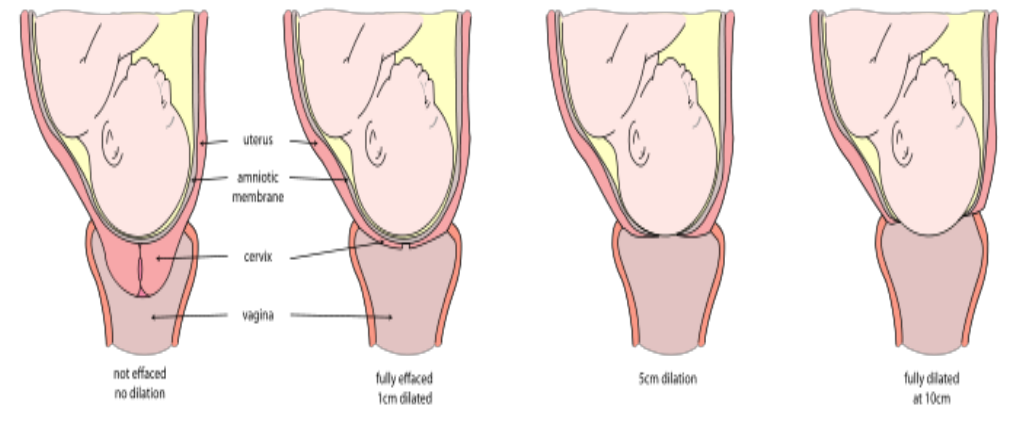There are three stages of labour
the first stage, when the cervix (neck of the womb)
opens to 10 centimetres
the second stage, when the baby moves down
through the vagina and is born
the third stage when the placenta (afterbirth) is
delivered.
‘Braxton Hicks’ contractions can occur throughout
pregnancy. These are tightening of the uterus and are
usually painless. During the latent phase Braxton Hicks
may become more noticeable and more frequent, lasting
35-45 seconds. However some women may not notice
anything happening at all.
What is the latent phase or early labour?
The latent phase of labour is the very first part of your
labour, the early part of the first stage
Before labour starts the cervix is long, situated towards
the back of your pelvis, firm and closed.
During the latent phase the muscles of the uterus
(womb) contract and make the cervix become thinner
and softer. This is called effacement or thinning. During
the latent phase the cervix thins out and opens up to 3-
4cm.
The next part of labour is called the active phase, when
labour has become established. Midwives may refer to
this as established labour.
Both the latent and the active phase are part of the first
stage of labour.
At the end of the first stage, the cervix will have opened
to 10cm and is known as being fully dilated.
The latent phase can last several days or weeks before
active labour starts. Some women can feel backache or
lower period type pain cramps. The pains can be
irregular with no particular pattern to them, and it is quite
common for the pains to last for a few hours and then
stop altogether. Contractions may continue for several
hours, but not become stronger or longer. This is
normal.
A ‘start-stop’ pattern of contractions is common in
the latent phase. Remember! The latent phase of
labour can last a very long time, especially for first
time mums.

Once you are in the active phase of labour, your
contractions will be regular and continue until your baby
is born. Your contractions will get stronger, longer and
closer together.
Many women are unsure of when the active part of
labour has begun, and may wish to attend triage to be
assessed and to be informed of progress in labour. If
you are still in the latent phase (if your cervix is less than
4cm dilated and not fully effaced) you will be advised to
return home and wait for the contractions to become
longer, stronger and closer together. Most women will
be more comfortable at home in the latent phase. There
is evidence to suggest the longer you stay at home the
more likely you are to have a normal birth. This leaflet
should help you find ways to cope with this.
What can I do in the latent phase of labour?
It is not possible to say when active labour will begin. It
could start in a couple of hours, or several days, so try to
stay as relaxed as you can, and distract yourself from
focussing only on the contractions. There are things you
can do to distract yourself, such as,
pottering around the house
taking a walk
watching a DVD
taking a warm bath, putting a bath towel in the
water with you to cover your tummy and keep it
warm
using a hot water bottle on any areas that ache
such as your back, tummy, under your bump, or
between your thighs
having a nap
doing some relaxation
massage
keep your breathing quiet and relaxed, breath in
gently, and sigh out slowly
keep as mobile as you can, while remembering to
rest when needed to save energy for active labour
try out different positions to become comfortable
such as
standing, squatting, kneeling using pillows, bean
bags and birthing balls
drink plenty of fluids; water, sports drinks and juice
are good
eat little and often, carbohydrates (bread pasta,
rice and cereal) for slow release of energy, plus
sugary foods, such as sweets or glucose tablets
for quick release energy
listening to calming and relaxing music
You can safely take paracetamol or co-codamol 6
hourly within the recommended dose.
You may find it helps to have sex. This causes
your body to produce oxytocin, this is a hormone
which is also produced in labour and which makes
the uterus contract.
TENS machines can be used in the latent phase.
Your birth partner can help with the latent phase with
things such as
massage
keeping you active
getting you drinks
praising and encouraging
giving you cuddles
Keeping you company and distracting you from
focussing on the pain.
You can help your labour to carry on smoothly by
avoiding stimulating the ‘rational’ part of your brain.
You need peace, quiet, and a feeling of safety to help
you relax and so increase the levels of your own
natural pain relievers called endorphins.
During labour you can take measures such as avoiding;
bright lights
people asking you questions which you have to
think to answer
people talking to you during contractions
feeling as if people are watching you or judging you.
If your waters break before labour
during pregnancy, your baby is surrounded by
amniotic fluid (the waters)
before active labour starts, your waters may break
for some women the first sign that labour is going to
start is that the waters begin to leak
It is quite common for women to leak a small
amount of urine at the end of pregnancy and it can
be difficult to tell if your waters have broken or if it is
urine
If you are not sure if your waters have broken, put a
sanitary towel on and lie down for about 30 minutes.
If you have a definite gush when you stand up, it is
a clear sign that your waters have broken and you
should telephone triage.
If not, then you can assume your waters have not
broken.
It is advisable once you think your waters have
broken to contact triage to be informed of what
happens next.
If your water is any colour other than clear you
must contact triage immediately.
It can be common for your waters to break and for
you not to go into labour, if this happens you will be
assessed in triage and sent home, and advised to
return 24 hours after your waters have broken to
have labour induced.
The ‘show’
The show is a mucous plug that sits in the cervix during
pregnancy, as the cervix begins to soften and shorten,
the show can come away.
It can be clear mucus, lightly coloured with blood or
quite heavily stained with blood. Any form of the show is
normal, and individual to each woman. As long as this is
mucousy, thick and sticky in appearance you do not
have to inform triage until you have any further signs of
labour.
If you experience what you think may be labour
before 37 weeks, you must contact triage for advice.

Things you can do to help yourself before labour
starts
Remember your body knows how to give birth. When
you can understand what helps and hinders the natural
process you can create the right environment for
yourself.
Communicate with your midwife during
pregnancy; make sure you find out as much
information as you can from her.
Attend antenatal classes and active birth
workshops
Some women find it helpful to read The
Pregnancy Book free to first time mums
Other women use the internet. Try the National
Childbirth Trust website www.nct.org.uk
You can write a birth plan so we can understand
your needs and feelings about labour.
Think positively about the strength and reliability
of your body.
University Hospital of South Manchester
Southmoor road
M23 9LT
http://www.uhsm.nhs.uk
Triage telephone number 0161 291 2724
Editorial Board No : 1152/14
Review Date : September 2016

Coping with the latent phase of
labour Advice for women
